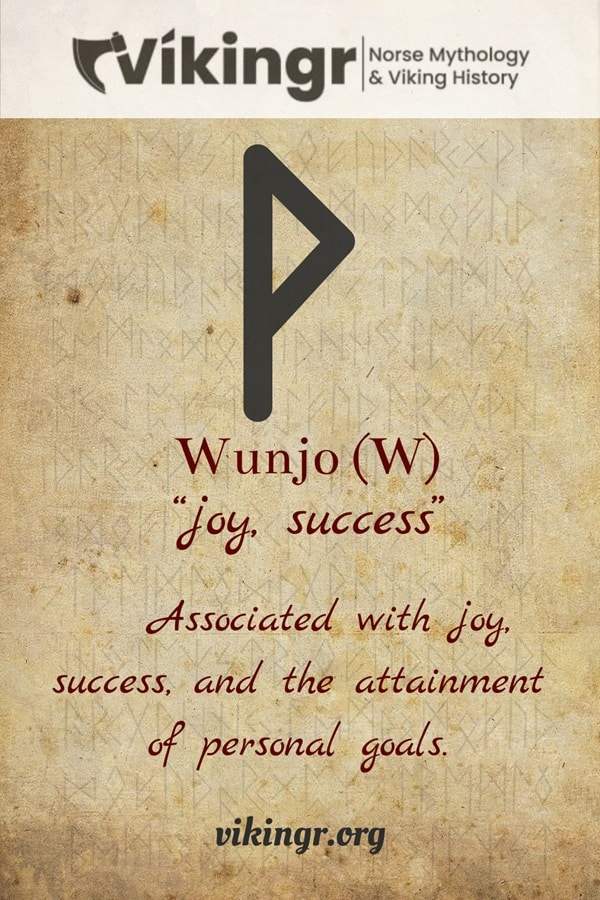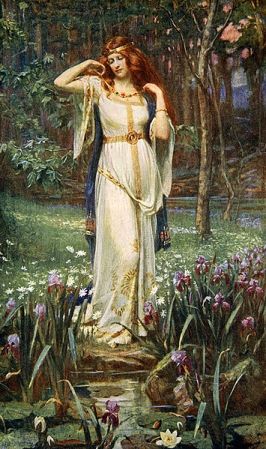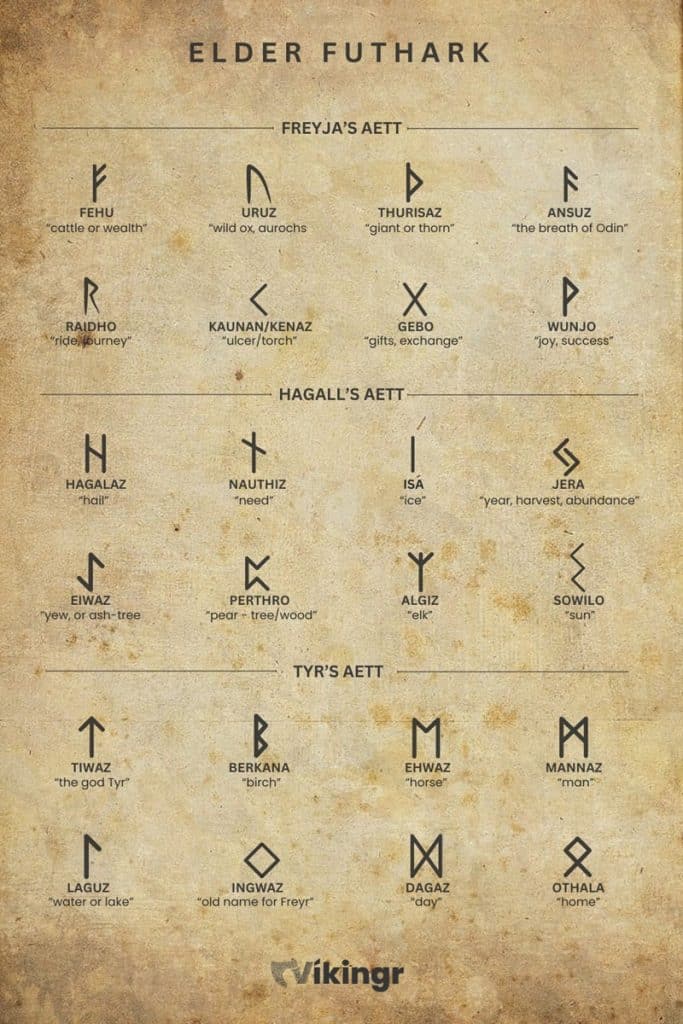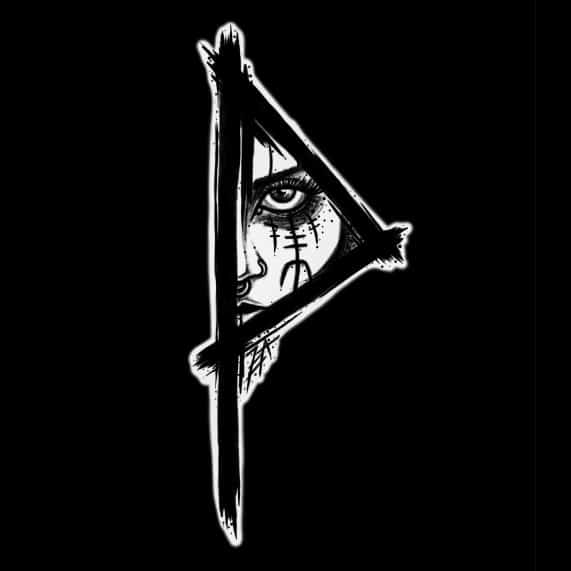Welcome back, fellow seekers of ancient wisdom! Today, we’re journeying once more into the world of the Vikings and their enigmatic runic system, the Elder Futhark. Our focus? The eighth rune in this ancient alphabet, Wunjo, a symbol of joy and harmony.
Background and Description
Let’s start at the beginning, with the Elder Futhark, the oldest form of the runic alphabets. Wunjo, the eighth rune in this alphabet is the last rune in the first aett, associated with Freyja and Freyr. It follows Gebo and precedes Hagalaz from the second aett. The name comes from Old Norse, translating roughly to “joy” or “bliss.”
Germanic tribes of people from the Iron Age and into the Viking Age used the Elder Futhark across Europe. Wunjo, along with its runic siblings, belonged to this widespread alphabet, and we can find it today on ancient artifacts that could be as old as two thousand years.
Transitioning to its origins, the etymology of “Wunjo” is intriguing. Rooted in the Proto-Germanic “*wunjō,” it’s associated with joy, pleasure, and even wishes. Consequently, this gives us a glimpse into the mindset of the ancient Germanic peoples, showing us that they valued joy and sought it in their lives.

Graphical Representation
Visually, Wunjo is a simple yet elegant rune. It’s composed of a vertical line with a leaf, or triangular flag, angled to the right at the top. It is forming a shape reminiscent of a flag on a golf course.
Historically, variations of Wunjo’s design have been found. Some inscriptions show the rune with more curved branches or with the branches angled to the left. However, the traditional form remains the most recognized and used.
Phonetic Value
In the Proto-Germanic language, Wunjo represented the sound “w,” as in “wind.” As Germanic languages evolved, so did the pronunciation of this rune. In Old Norse, for example, it was pronounced as a “v.”
Symbolic Meaning of the Wunjo Rune
Now, let’s delve into the symbolic heart of Wunjo. This rune is traditionally associated with joy, pleasure, and fulfillment. It represents the culmination of efforts, the reward at the end of a journey, or the realization of a wish.
The rune is also linked to harmony and well-being, reflecting a state of contentment and peace. It’s a reminder of the importance of happiness and joy in life, and the role they play in a balanced and fulfilling existence.

The Goddess of Love, Freyja, is a central figure in Norse mythology, embodying love, beauty, and fertility. Wunjo, with its associations with joy and fulfillment, reflects these themes, offering a glimpse into the values and beliefs of the ancient Germanic peoples.
The Aett and its Symbolism
Wunjo belongs to the first aett of the Elder Futhark, a group of eight runes associated with the god Freyr and the goddess Freyja. This aett, or family of runes, carries themes of prosperity, fertility, and the cyclical nature of life.
Freyr and Freyja, the divine Vanir siblings, are central figures in this aett. They embody the life-affirming energies of growth, prosperity, and love. Wunjo, with its themes of joy and fulfillment, adds a layer of positivity to this aett, reminding us that life is not just about struggle, but also about finding joy and satisfaction.

Elder Futhark Quiz
Do you want to test your knowledge of Elder Futhark runes? Then this quiz is perfect for you!
Don’t forget to play our other games as well!
Wunjo Used in Divination and Magic
While I don’t personally have any experience with the practice of divination, I find it increasingly fascinating. In runic divination, Wunjo is often interpreted as a sign of joy, fulfillment, or the culmination of a journey. It may suggest a period of happiness and satisfaction coming into one’s life.

Historically, people used Wunjo and runes in general in magical seidr practices. Although we lack concrete evidence of specific spells or rituals, it’s plausible that practitioners invoked the rune’s associations with joy and fulfillment in magical contexts. Imagine a Viking etching this rune onto a talisman, hoping to bring joy and satisfaction into their life.
In modern times, some practitioners of runic magic use Wunjo in spells or rituals aimed at attracting joy, fulfillment, or satisfaction. Again, while I don’t personally practice this, I respect the cultural significance and personal meaning it holds for many.
Wunjo in the Younger Futhark – The Vanishing Joy
In the period when the Elder Futhark was evolving into the Younger Futhark, around the 7th and 8th centuries, Wunjo, representing joy and harmony, vanishes. Its disappearance marks a shift in the expression of emotions and social harmony, reflecting the ever-evolving nature of human experience and language.
Frequently Asked Questions
Wunjo represents joy, fulfillment, and the culmination of a journey. It’s associated with happiness and satisfaction.
In Old Norse, Wunjo is pronounced with a “w” sound, similar to “wind.”
In divination, Wunjo often signifies a period of joy, fulfillment, or the culmination of a journey coming into one’s life.
Wunjo is the last rune in the first aett of the Elder Futhark, associated with Freyr and Freyja.
Featured Image Credit: BK, Public domain, via Wikimedia Commons
